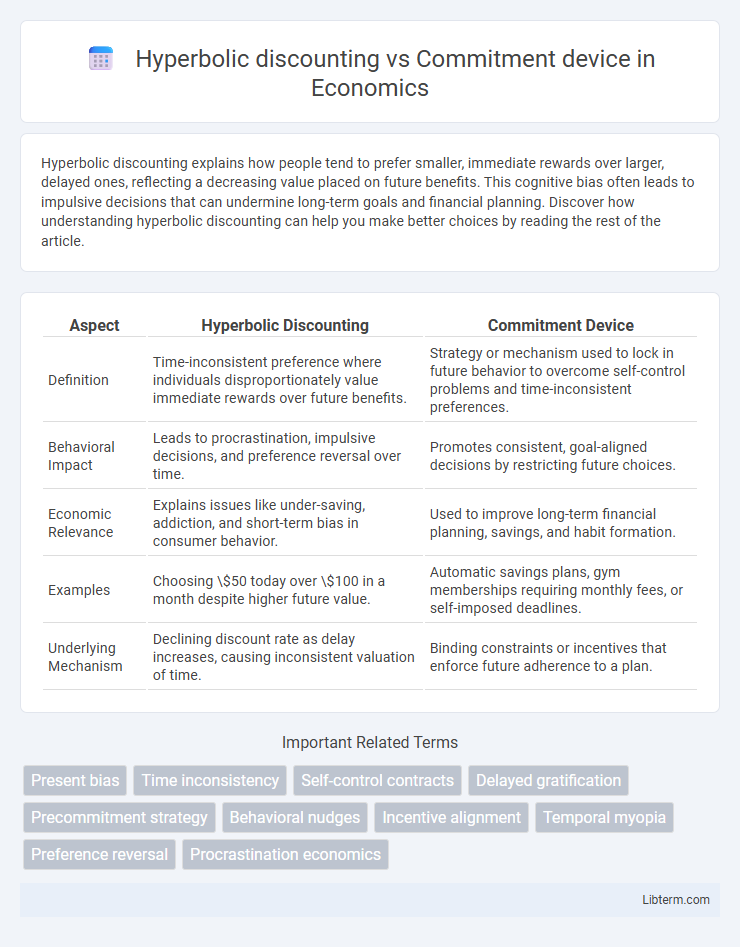Hyperbolic discounting explains how people tend to prefer smaller, immediate rewards over larger, delayed ones, reflecting a decreasing value placed on future benefits. This cognitive bias often leads to impulsive decisions that can undermine long-term goals and financial planning. Discover how understanding hyperbolic discounting can help you make better choices by reading the rest of the article.
Table of Comparison
| Aspect | Hyperbolic Discounting | Commitment Device |
|---|---|---|
| Definition | Time-inconsistent preference where individuals disproportionately value immediate rewards over future benefits. | Strategy or mechanism used to lock in future behavior to overcome self-control problems and time-inconsistent preferences. |
| Behavioral Impact | Leads to procrastination, impulsive decisions, and preference reversal over time. | Promotes consistent, goal-aligned decisions by restricting future choices. |
| Economic Relevance | Explains issues like under-saving, addiction, and short-term bias in consumer behavior. | Used to improve long-term financial planning, savings, and habit formation. |
| Examples | Choosing \$50 today over \$100 in a month despite higher future value. | Automatic savings plans, gym memberships requiring monthly fees, or self-imposed deadlines. |
| Underlying Mechanism | Declining discount rate as delay increases, causing inconsistent valuation of time. | Binding constraints or incentives that enforce future adherence to a plan. |
Understanding Hyperbolic Discounting
Hyperbolic discounting describes the tendency of individuals to prefer smaller, immediate rewards over larger, delayed ones due to a decreasing rate of time discounting. This cognitive bias leads to inconsistent decision-making, where people disproportionately value present benefits at the expense of future gains. Commitment devices serve as tools to counteract hyperbolic discounting by binding individuals to long-term goals and reducing impulsive choices that undermine their best interests.
The Psychology Behind Immediate Gratification
Hyperbolic discounting describes the tendency for individuals to disproportionately prefer smaller immediate rewards over larger future gains due to a steep decline in value perception over time, revealing a psychological bias toward immediate gratification. Commitment devices serve as external or self-imposed mechanisms that help individuals overcome this bias by restricting future choices, thereby promoting long-term goal adherence. Understanding the psychological roots of immediate gratification is crucial for designing effective commitment strategies that align short-term impulses with long-term interests.
Commitment Devices: Definition and Types
Commitment devices are strategies or tools designed to help individuals overcome self-control problems by locking in future behavior to align with long-term goals. Common types include financial commitments like savings accounts with withdrawal restrictions, behavioral contracts that impose penalties for non-compliance, and digital applications that limit access to distractions such as social media or gambling sites. These mechanisms counteract hyperbolic discounting by reducing temptation and promoting consistent adherence to intended actions over time.
How Commitment Devices Counteract Hyperbolic Discounting
Commitment devices counteract hyperbolic discounting by restricting future choices to align short-term actions with long-term goals, effectively reducing impulsive decision-making driven by immediate rewards. These mechanisms, such as automatic savings plans or self-imposed deadlines, increase the cost of deviating from intended behaviors, thereby promoting consistent adherence to beneficial outcomes. By structurally limiting the impact of present bias, commitment devices enhance self-control and improve long-term decision quality.
Behavioral Economics: Linking Theory to Practice
Hyperbolic discounting explains why individuals disproportionately prefer immediate rewards over future gains, leading to time-inconsistent choices and procrastination in behavioral economics. Commitment devices serve as practical tools that help individuals align their short-term behaviors with long-term goals by restricting future choices or imposing penalties for deviations. Integrating these concepts bridges theoretical models of discounting with real-world strategies to improve self-control and enhance decision-making outcomes.
Real-World Examples of Hyperbolic Discounting
Hyperbolic discounting explains why individuals prefer smaller, immediate rewards over larger, delayed benefits, often leading to impulsive decisions like choosing fast food over healthier meals or procrastinating on saving for retirement. Commitment devices, such as automatic savings plans or gym membership contracts, help counteract this by restricting future choices to align with long-term goals. Real-world examples include using apps that lock away funds to prevent impulsive spending and prepaying for fitness programs to ensure consistent exercise despite short-term temptations.
Successful Application of Commitment Devices
Commitment devices effectively counteract hyperbolic discounting by restricting future choices to align with long-term goals, enhancing self-control and reducing impulsive decisions. Successful applications include automatic savings plans, where funds are locked into accounts to prevent premature spending, and fitness contracts that impose penalties for missed workouts, promoting sustained behavioral change. These mechanisms leverage precommitment to bridge the gap between immediate temptation and future benefits, improving outcomes in financial planning, health, and productivity.
Limitations of Commitment Devices
Commitment devices help individuals overcome hyperbolic discounting by locking in future behaviors to avoid impulsive decisions, but they often face limitations such as reduced flexibility and the potential for circumvention or failure to anticipate changing preferences. These devices may also impose psychological costs or financial penalties that deter consistent use, limiting their effectiveness over time. Moreover, reliance on external commitment tools can undermine intrinsic motivation, reducing long-term behavioral change sustainability.
Comparing Effectiveness: Hyperbolic Discounting vs. Commitment Device
Hyperbolic discounting often leads individuals to prioritize immediate rewards over long-term benefits, causing inconsistent decision-making and self-control issues. Commitment devices improve effectiveness by restricting future choices, thereby counteracting impulsive tendencies and promoting consistent goal adherence. Studies show that while hyperbolic discounting explains procrastination and short-sightedness, commitment devices significantly enhance self-regulation and long-term decision success.
Strategies for Overcoming Impulsive Decision-Making
Hyperbolic discounting causes individuals to prioritize immediate rewards over long-term benefits, leading to impulsive decisions. Commitment devices strategically lock in future behavior by creating consequences for deviating from a set plan, helping to counteract this bias. Effective strategies include automated savings plans and binding agreements that align short-term actions with long-term goals.
Hyperbolic discounting Infographic

 libterm.com
libterm.com